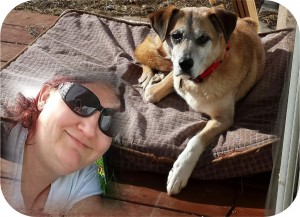Communicating With a Deaf Dog Teaching an Old Dog New Tricks
Our guest blogger this week, Old Dog Haven foster mom Tonya Kniest, shares her thoughts about teaching a deaf old dog new tricks. Pictured right are Tonya with Lizzy. 
My first Final Refuge foster, Lizzy, came to me deaf, tail tucked, and fearful of sudden moves toward her, even trying to scramble to the back door if gently directed by her collar to a different place. It seemed as though this sweet, gentle, 40 pound girl had been handled roughly in her former life. Wanting to give her some positive experiences, as well as assurance that she would come to me if needed, I decided to try some positive reinforcement training.
But what do you do when the dog can’t hear the word? Well, dogs don’t speak English anyway, and are good at judging our body language (think how they get excited when you’re putting on your shoes and heading toward the leash holder). So how about hand signals? I remembered reading years ago, early in my dog training experience, that even while they are hearing-able puppies, we should teach our dogs hand cues to go along with the verbal ones, so that if the pup should lose the ability in old age, he can still respond.
It can also be a safety issue. Imagine if the dog somehow got loose and was across a busy street. If she can see you, you can give a sit/stay hand signal that, if trained well enough, could keep the dog safely in place until you could get to her. I experienced that first hand once when my own young dog was lured away at full speed by a bunny. Fortunately there was no traffic, but he was 100 yards away by the time he realized he’d gotten that far from mom and I needed him to stop where he was until I got to him. Thankfully we’d worked on that and he stayed where he was.
I used this concept to first teach Lizzy “come.” With a treat in my left hand I would let her smell it, step a foot or so away from her, bend forward slightly then roll my right wrist in a circle with my hand flat. As she stepped forward for the treat, I’d give it along with big smiles and enthusiastic pets – cheers too, but it’s hard to train us silly humans to not be verbal. After a couple times, I’d increase the distance. Within a couple days, I could go to the other side of the room and do the wrist roll, and she would come to me! Soon after, it would work all the way across the back yard. Quite “handy” when I needed to call her and her hearing foster siblings in the house.
Even more than that, it made her so very happy to do the right thing. As our incredibly wise ODH director Judith Piper pointed out, this positive training “gives her confidence and lets her do something right [when it seems] like she was told the opposite before.” It not only built her confidence, but also the bond between us; she knew that my hands would mean treats and belly rubs, not punishment.
Once we had “come” down, we also learned “sit,” “down,” “shake,” and “speak.” I think the learning process made Lizzy and me equally happy.
This “old dog, new tricks” training is beneficial in another way; it keeps the minds of our sweet seniors active whether their hearing is intact or not. This stimulation is especially important if the early signs of dementia are setting in (see previous ODH blog post for more information about that). They don’t have to learn to open doors or perform complicated tricks. Something as simple as “shake” or “spin” is enough to help get the neurons firing for a bit.
Dementia is what ultimately took Lizzy away from me, but I’d like to think that some of the tricks we practiced helped extend the time I had with her. She would be a little foggy, pacing in the back yard as though she forgot how to come in. I’d catch her eye and give her the “come” signal to get her in the house and then spend a few minutes going through the stuff we’d learned. Things like “sit” and “shake” were simple, but nonetheless she’d come out of the fog. Her eyes would brighten and her tail would wag again.
While everything about being an ODH Final Refuge foster is rewarding, making my girl happy through training was just icing on the cake. That’s the ultimate positive reinforcement. I only had a year with this lovely lady, but she left an eternal paw print on my heart.

